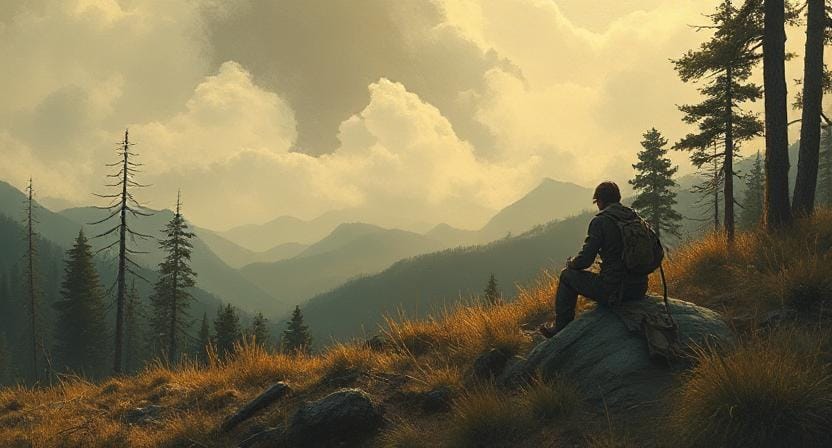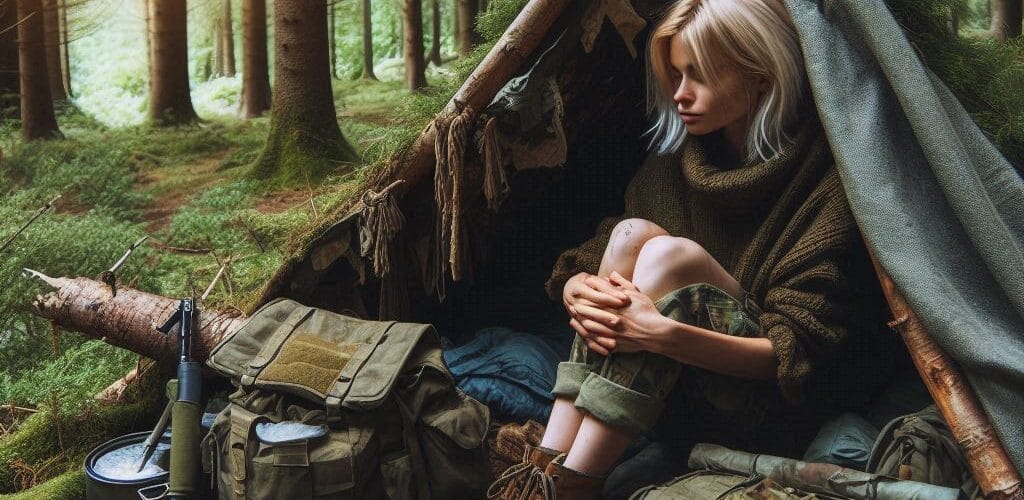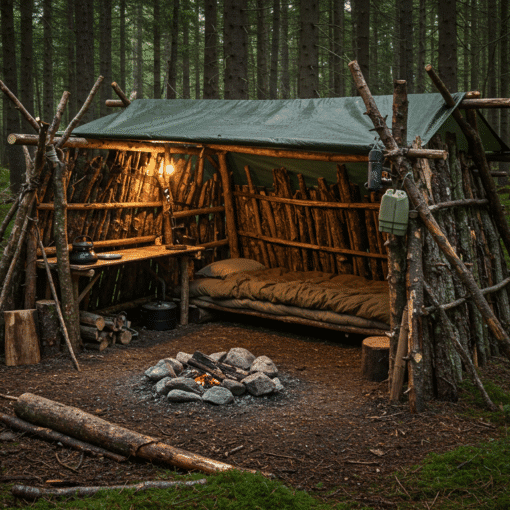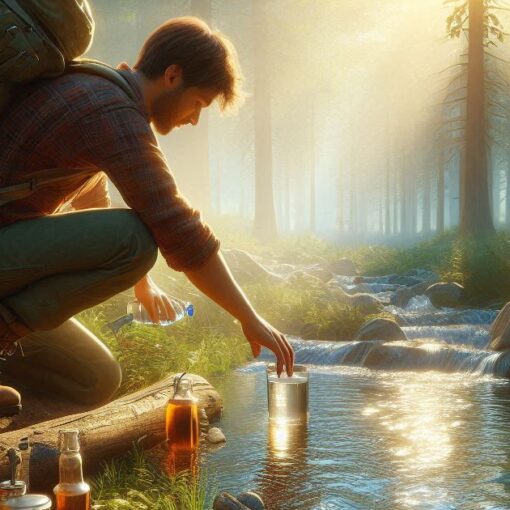Please Note: This post may contain affiliate links. If you click one of them, we may receive a commission at no extra cost to you. As an Amazon Associate, I earn from qualifying purchases.
Top Takeaways and Key Concepts
- Keep a calm mindset — Use the SPEAR method: Stop, Plan, Execute, Assess, Re-evaluate before acting.
- Build proper shelter — Choose safe, dry spots and insulate from cold ground to prevent hypothermia.
- Find and purify water — Locate streams, collect rainwater, or boil and filter to ensure safe hydration.
- Master fire-making — Carry matches or flint, use dry wood, and practice ignition techniques in all weather.
- Learn your environment — Identify edible plants, track animals, and understand terrain to boost survival confidence.
Summary of This Article
This article breaks down essential wilderness survival skills for anyone exploring the great outdoors. It emphasizes staying calm under pressure, building shelter to stay protected, and securing clean water as a top priority. Readers learn to make fire for warmth and cooking, find food safely, and develop awareness of their surroundings through nature observation and practice. With the right mindset, preparation, and adaptability, anyone can thrive in the wild and turn survival into a story of strength and confidence.
Short Video Version of this Article
So, you wanna learn how to survive in the wild? That’s awesome! Whether you’re planning a fun camping trip or just want to be ready if your GPS goes haywire, it’s really smart to know some basics. Trust me, Mother Nature can be full of surprises.
First up, making a shelter. If it rains or gets chilly, you need a cozy spot. You don’t have to build a mansion! A simple tarp or some branches can do the trick. Even a big tree can protect you from the wind or rain. Finding a good place to rest is super important.
Next is starting a fire. Fire keeps you warm and cooks your food. It’s like your camp buddy. Gathering dry wood, twigs, and leaves is the way to go. Remember, a fire needs air, so don’t smother it. Then, whoosh! You’ve got light and warmth.

Finding water is another biggie. You can’t live without it, right? Always look for clear streams or lakes. If you can’t find any, collect rainwater. If you’re in a pinch, you can fill a container with grass or use a plastic bag to catch some moisture. Just make sure it’s clean.
Food, oh food. You don’t need a fancy restaurant in the wild. Look for berries that are safe to eat. Nuts are good too. If you know how to fish, that’s a bonus! Just be careful. You don’t wanna eat something that makes you feel icky. Always double-check what’s okay to munch on.
Finding your way can be hard. You can find your way by looking at the sun. It goes up in the east in the morning. It goes down in the west. It’s ideal if you have a map and a compass. If not, just remember that you can always go downstream on a river.
Lastly, staying calm is really important. Getting upset won’t help. Take a deep breath and think about what you want to do. When you’re in a panic, it can be hard to figure out what to do next. Have faith in your gut and keep a good attitude.
That’s it! You’ll be ready for anything with these survival skills in your pocket. You can do this! Be brave and embrace every moment.
1. Your Attitude: It’s All in Your Head
First and foremost, your attitude can determine whether you live or die. Seriously, how you think about things could be the difference between having a nice story to share later and not having one at all. Have you ever heard of “The Rule of Threes”? It’s like a cheat sheet for people who want to survive:
You can live for three minutes without air.
Without shelter, you can live for three hours in bad weather.
You have three days before not having enough water becomes a serious problem.
And what about food? You can last approximately three weeks before it’s all over.
Do you see how shelter and water are at the top? That’s your top priority, and you need to keep calm, composed, and focused.
When things get tough, remember the acronym SPEAR: Stop, Plan, Execute, Assess, and Re-evaluate. It’s like taking a break before you lose it, making a plan, and then doing things one at a time. Believe me, it works a lot better than freaking out and running in circles.
2. Shelter: Your First Line of Defense
 So, you’re out in the wild, and the weather decides to do its worst. Shelter is your best friend here. Most folks in survival situations run into trouble because they don’t have a decent place to crash. And let’s be real—hypothermia is not something you want to mess with.
So, you’re out in the wild, and the weather decides to do its worst. Shelter is your best friend here. Most folks in survival situations run into trouble because they don’t have a decent place to crash. And let’s be real—hypothermia is not something you want to mess with.
When building your shelter, think about these four things:
Location: Find a spot that’s safe and close to materials.
Insulation: Keep the cold, wind, and rain out. The ground’s not your friend here, so insulate yourself from it.
Heat Source: Use your body heat or, better yet, get a fire going.
Size: Are you on your own or with a group? That’ll determine how big your shelter needs to be.
Caves, hollow logs, or even a makeshift debris hut can be lifesavers. If you’re looking for a go-to, the debris hut is pretty much the Swiss Army knife of shelters—works in most places, and it’s not too hard to put together. You might want to learn how to make one before you actually need it.
3. Water: Liquid Gold
Water is your best buddy in the wild—no joke. It’s way more important than food. Your body is mostly water, like 78% or something wild like that. Staying hydrated isn’t just smart; it’s a must.
You want about a gallon a day. Sounds like a lot, right? But you’ll feel so much better. Clean water can be tricky to find, though. Keep an eye out for springs or streams. If you’re lucky, you might find a nice clear spot.
On tough days, collecting morning dew can save the day. Just grab some leaves or grass and squeeze the droplets into your container. Every little bit helps!
If you have gear, filters and chemical treatments are awesome. They make nasty water safe to drink. If that’s not an option, boiling is your go-to. Heat it up until it’s bubbling—like a happy hot tub. A good rolling boil for a few minutes gets rid of most of the yucky stuff.
Just remember, water is essential. Keep your eyes peeled and always have a plan to find some. You’ll thank yourself later, trust me!
4. Fire: Your Multi-Tool
Fire’s not just for roasting marshmallows, you know. It’s your warm hug on cold nights, your cooking buddy, and it even lifts your spirits. When things get tough, knowing how to start a fire can really change the game.
So, let’s talk gear. Pack some fire-starting tools like lighters or matches. They’re simple and super handy. A flint and steel can be cool too. Practice lighting a fire in different weather. You’ll feel like a pro!
If you ever find yourself without easy tools, don’t worry. There’s always the old-school way. Learning to start a fire by rubbing sticks together can sound tough, but it can work. Bow drills, hand drills, and fire plows might feel like something out of a superhero movie, but they can save the day.
Just imagine—you’re sitting by a cozy fire after a long day outside. Sounds nice, right? So get out there, practice, and don’t be afraid to mess up a bit. Each try will help you get better, and you’ll be glad you did it when you really need it.
5. Food: Don’t Panic Yet
Food might feel like a biggie, but you’ve got some time before hunger becomes a real problem. Remember the “Rule of Threes.” Three weeks without food is a lot longer than you think. But let’s be real—going without food isn’t fun.
Good news! There’s actually a buffet out there in nature. Wild plants, insects, and tiny animals can help fill your belly. Just make sure you know what’s safe to eat.
Some plants look friendly but can be sneaky, hiding poison in their looks. Knowing how to identify them is super important. You don’t want to end up feeling worse instead of better. If you find yourself in a swamp, look for cattails. They’re like the ultimate survival snack station. You can eat their roots and shoots. They’ve got you covered.
Taking a little time to learn about safe food can make a huge difference later. It can feel a bit weird at first. But trust me, once you get the hang of it, you’ll feel a lot more confident out there. So go explore, and maybe even try a nibble or two. Who knows? You might just discover a new favorite snack!
 6. Nature Skills: Be a Wilderness Whisperer
6. Nature Skills: Be a Wilderness Whisperer
Having a good sense of nature is like having a cool superpower. The more you know about the world outside, the easier it will be to do well. Being able to track animals, discover plants that can benefit you, and know the lay of the terrain can make a tremendous difference. You can do it too, just as our predecessors did!
Get some field guides for your area if you truly want to get good at this. They show where plants and animals can get food. Find out what’s around you and how it all fits together. The more you know, the more confident you’ll feel out there.
Don’t rush through your exploration. You may go for a walk and start paying close attention to what you notice. Can you see any fascinating birds or plants that catch your eye? It can be fun! As you learn more about your environment, you’ll start to feel like an expert.
All of this information will help you do well in the wild. Everything is ready for you; it’s only waiting. If you have a positive mindset, some abilities, and a little practice, you’ll be ready for everything nature throws at you. Also, excursions can be a lot of fun! Think about how you’ll share your stories afterward. It’s much better to be the one recounting such stories than the one who didn’t get to go on the journey. So, what do you think? Let’s go see what’s out there!
Featured Snippet: Learning survival skills helps you stay calm, safe, and confident in the wilderness. From building shelter and finding clean water to starting fires and identifying edible plants, mastering these basics ensures you’re ready to handle any outdoor challenge with skill and resilience.
Frequently Asked Questions
What is the most important survival skill to learn first?
Staying calm and thinking clearly is the most vital skill. A steady mindset helps you plan, act wisely, and avoid panic in challenging situations.
How do I find safe drinking water in the wild?
Look for running streams, rainwater, or morning dew. Always boil or filter the water before drinking to remove harmful bacteria and parasites.
What materials can I use to build a shelter?
Use natural materials like branches, leaves, and grass, or tools like tarps and rope to build a safe, insulated shelter that protects from wind and rain.
How can I start a fire without matches or a lighter?
Try using flint and steel, a bow drill, or friction-based methods. Practice before you need it so you can light a fire quickly in any weather.
What are some safe foods to eat in the wild?
Look for familiar nuts, berries, and edible plants. Avoid anything with a bitter taste or milky sap, and learn to identify local safe options before your trip.
How can I avoid getting lost while hiking or camping?
Always carry a map and compass, note landmarks, and leave a trip plan with someone. If you get lost, stay calm, retrace steps, and look for streams leading downstream.
Why is learning about nature so important for survival?
Understanding your environment helps you find food, water, and shelter faster while avoiding hazards. Nature awareness boosts confidence and decision-making in survival scenarios.

Kevin Collier is a seasoned outdoor enthusiast and writer for Trekbug.com, specializing in outdoor adventures, survival strategies, and prepping insights. With a deep love for nature and a commitment to self-sufficiency, Kevin empowers readers to embrace the wilderness confidently. He shares valuable tips, practical techniques, and inspiring stories, helping both novice and experienced adventurers develop essential skills for surviving and thriving in the great outdoors.


 6. Nature Skills: Be a Wilderness Whisperer
6. Nature Skills: Be a Wilderness Whisperer


